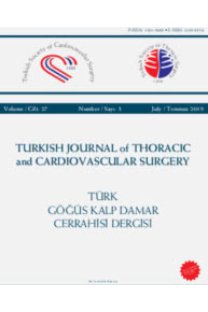Koroner arter bypass cerrahisi sonrası erken dönemde aspirin direnci gelişme sıklığı ve tromboksan A2 üretiminin yetersiz inhibisyonu
Frequency of development of aspirin resistance in the early postoperative period and inadequate inhibition of thromboxane A2 production after coronary artery bypass surgery
___
- Hankey GJ, Eikelboom JW. Aspirin resistance. Lancet 2006;367:606-17.
- Shantsila E, Watson T, Lip GY. Aspirin resistance: what, why and when? Thromb Res 2007;119:551-4.
- Weber AA, Przytulski B, Schanz A, Hohlfeld T, Schrör K. Towards a definition of aspirin resistance: a typological approach. Platelets 2002;13:37-40.
- Krasopoulos G, Brister SJ, Beattie WS, Buchanan MR. Aspirin “resistance” and risk of cardiovascular morbidity: systematic review and meta-analysis. BMJ 2008;336:195-8.
- Mason PJ, Jacobs AK, Freedman JE. Aspirin resistance and atherothrombotic disease. J Am Coll Cardiol 2005;46:986-93.
- Boysan E, Unal EU, Yay K, Bardakcı H, Birincioglu CL. Effect of cardiopulmonary bypass on acetyl salicylic acid resistance in patients undergoing isolated elective coronary artery bypass graft surgery. Turk Gogus Kalp Dama 2013;21:261-7.
- Hobikoglu GF, Norgaz T, Aksu H, Ozer O, Erturk M, Nurkalem Z, et al. High frequency of aspirin resistance in patients with acute coronary syndrome. Tohoku J Exp Med 2005;207:59-64.
- Grundmann K, Jaschonek K, Kleine B, Dichgans J, Topka H. Aspirin non-responder status in patients with recurrent cerebral ischemic attacks. J Neurol 2003;250:63-6.
- Roller RE, Dorr A, Ulrich S, Pilger E. Effect of aspirin treatment in patients with peripheral arterial disease monitored with the platelet function analyzer PFA-100. Blood Coagul Fibrinolysis 2002;13:277-81.
- Macchi L, Christiaens L, Brabant S, Sorel N, Allal J, Mauco G, et al. Resistance to aspirin in vitro is associated with increased platelet sensitivity to adenosine diphosphate. Thromb Res 2002;107:45-9.
- Hovens MM, Snoep JD, Eikenboom JC, van der Bom JG, Mertens BJ, Huisman MV. Prevalence of persistent platelet reactivity despite use of aspirin: a systematic review. Am Heart J 2007;153:175-81.
- Yilmaz MB, Balbay Y, Caldir V, Ayaz S, Guray Y, Guray U, et al. Late saphenous vein graft occlusion in patients with coronary bypass: possible role of aspirin resistance. Thromb Res 2005;115:25-9.
- Ballotta A, Saleh HZ, El Baghdady HW, Gomaa M, Belloli F, Kandil H, et al. Comparison of early platelet activation in patients undergoing on-pump versus off-pump coronary artery bypass surgery. J Thorac Cardiovasc Surg 2007;134:132-8.
- Møller CH, Steinbrüchel DA. Platelet function after coronary artery bypass grafting: is there a procoagulant activity after off-pump compared with on-pump surgery? Scand Cardiovasc J 2003;37:149-53.
- Cornelissen J, Kirtland S, Lim E, Goddard M, Bellm S, Sheridan K, et al. Biological efficacy of low against medium dose aspirin regimen after coronary surgery: analysis of platelet function. Thromb Haemost 2006;95:476-82.
- Helgason CM, Bolin KM, Hoff JA, Winkler SR, Mangat A, Tortorice KL, et al. Development of aspirin resistance in persons with previous ischemic stroke. Stroke 1994;25:2331-6.
- Gum PA, Kottke-Marchant K, Poggio ED, Gurm H, Welsh PA, Brooks L, et al. Profile and prevalence of aspirin resistance in patients with cardiovascular disease. Am J Cardiol 2001;88:230-5.
- Friend M, Vucenik I, Miller M. Research pointers: Platelet responsiveness to aspirin in patients with hyperlipidaemia. BMJ 2003;326:82-3.
- Macchi L, Christiaens L, Brabant S, Sorel N, Allal J, Mauco G, et al. Resistance to aspirin in vitro is associated with increased platelet sensitivity to adenosine diphosphate. Thromb Res 2002;107:45-9.
- Furman MI, Benoit SE, Barnard MR, Valeri CR, Borbone ML, Becker RC, et al. Increased platelet reactivity and circulating monocyte-platelet aggregates in patients with stable coronary artery disease. J Am Coll Cardiol 1998;31:352-8.
- Watala C, Golanski J, Pluta J, Boncler M, Rozalski M, Luzak B, et al. Reduced sensitivity of platelets from type 2 diabetic patients to acetylsalicylic acid (aspirin)-its relation to metabolic control. Thromb Res 2004;113:101-13.
- Abaci A, Yilmaz Y, Caliskan M, Bayram F, Cetin M, Unal A, et al. Effect of increasing doses of aspirin on platelet function as measured by PFA-100 in patients with diabetes. Thromb Res 2005;116:465-70.
- Coma-Canella I, Velasco A, Castano S. Prevalence of aspirin resistance measured by PFA-100. Int J Cardiol 2005;101:71-6.
- Capone ML, Sciulli MG, Tacconelli S, Grana M, Ricciotti E, Renda G, et al. Pharmacodynamic interaction of naproxen with low-dose aspirin in healthy subjects. J Am Coll Cardiol 2005;45:1295-301.
- Catella-Lawson F, Reilly MP, Kapoor SC, Cucchiara AJ, DeMarco S, Tournier B, et al. Cyclooxygenase inhibitors and the antiplatelet effects of aspirin. N Engl J Med 2001;345:1809-17.
- Buchanan MR, Schwartz L, Bourassa M, Brister SJ, Peniston CM. Results of the BRAT study--a pilot study investigating the possible significance of ASA nonresponsiveness on the benefits and risks of ASA on thrombosis in patients undergoing coronary artery bypass surgery. Can J Cardiol 2000;16:1385-90.
- ISSN: 1301-5680
- Yayın Aralığı: 4
- Başlangıç: 1991
- Yayıncı: Bayçınar Tıbbi Yayıncılık
Tesadüfi intrahepatik portal ven anevrizması
Periferik yerleşimli, bronşiyal olmayan nadir bir pulmoner mukus bezi adenomu olgusu
Ahmet ULUŞAN, Kemal BAKIR, Zeynep BAYRAMOĞLU, Maruf ŞANLI
Baraitser-Winter sendromlu erişkin bir hastada Bentall prosedürü deneyimimiz
Yüksel ATAY, Çağatay BİLEN, Gökmen AKKAYA, Osman Nuri TUNCER, Mehmet Fatih AYIK
Mehmet GAMSIZKAN, Onur GENÇ, Kuthan KAVAKLI, Yusuf Sinan ŞİRİN, Hasan ÇAYLAK, Ersin SAPMAZ
Mustafa TAŞAR, Uğurcan BALYEMEZ, Bülent KARAMAN, Uğur BOZLAR
Nuss işleminde komplikasyonları belirleyen faktörler
Özgür KATRANCIOĞLU, Nurkay KATRANCIOĞLU, Ekber ŞAHİN, Şule KARADAYI, Tuba ŞAHİNOĞLU, Yücel AKKAŞ
Modifiye Bentall ameliyatı yapılan bir hastada periferik emboli
Ersin KADİROĞULLARI, Onur ŞEN, Barış TİMUR, Mehmet KAYA
Tekrarlayan hızlı homogreft dejenerasyonu ve yaygın kalsifikasyonu
Muhammet AKYÜZ, Ali Rahmi BAKİLER, Onur IŞIK, Fulya KAMİT CAN
Evre I akciğer adenokarsinomu için prognostik faktörler ve subsolid nodüllerin cerrahi yönetimi
Atilla Halil ELHAN, Mustafa Bülent YENİGÜN, Ayten Kayı CANGIR, Cabir YÜKSEL, Gökhan KOCAMAN, Serkan ENÖN, Serpil DİZBAY SAK, Elvin HAMZAYEV
Hakan GERÇEKOĞLU, Bülent AYDEMİR, Eyüp Halit YARDIMCI, Melek Didem PEKÖZ, Tamer OKAY
